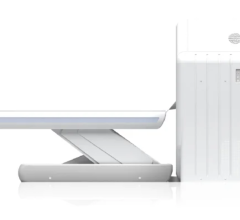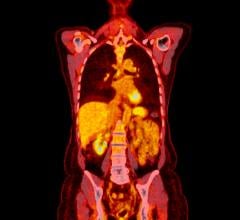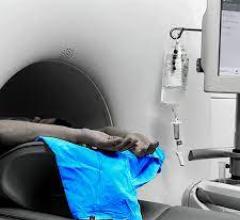
Frank M. Bengel, MD, is the director of cardiovascular nuclear medicine and an associate professor of radiology and medicine at Johns Hopkins University.
In the pre-clinicial trial Expanding the Versatility of Cardiac PET/CT: Feasibility of Delayed Contrast Enhancement CT for Infarct Detection in a Porcine Model (Holz1, A., et al)*, researchers found that infarct size can be measured accurately and reproducibly using cardiac PET/CT with delayed CT-enhancement.
To measure the infarct size, a low-dose, prospectively gated acquisition was comparable to higher-dose spiral CT. These results provided a rationale for further clinical work to explore whether delayed CT-enhancement can improve the accuracy of myocardial viability assessment, substitute for rest studies in perfusion imaging, or improve localization of PET-derived molecular signals.
To learn more about the potential for the technique described to be used in a clinical setting, Imaging Technology News spoke with one of the researchers in the study, Frank M. Bengel, M.D., director of cardiovascular nuclear medicine and an associate professor of radiology and medicine, at Johns Hopkins University.
Imaging Technology News (ITN): Dr. Bengel, the study reports that: “Similar to MRI, CT can be used to detect infarcts at high resolution by delayed myocardial contrast enhancement. But with cardiac PET/CT, the ability to detect infarcts may increase the versatility and integrative potential of PET and CT study components.”
What is the feasibility of delayed myocardial contrast CT-enhancement in the PET/CT?
Dr. Frank Bengel: It’s a technique that’s been adopted from MRI, which was established using MRI more than 10 years ago. The idea behind that is that scar tissue or areas of myocardial infarction will have longer retention of contrast agent compared to healthy normally infused myocardium. Therefore, if you take contrast agent rate for the sufficient amount of time then you can take the accumulation of the rate enhancement of the contrast agent into scar tissue.
ITN: In cardiac PET/CT is this one of the first times this technique has been used?
Dr. Bengel: In cardiac CT as a stand-alone technique actually colleagues of mine at Hopkins were among the first to use it with cardiac CT as a stand-alone. They started using it about three or fours years ago. To my knowledge, our study is the first to use it in the PET/CT environment. I am not aware of any other group using this with PET/CT.
ITN: What was your objective for using PET/CT?
Dr. Bengel: There were a couple of the issues. Firstly, the number of reports using this delayed enhancement technique with stand-alone CT was limited at the time we began our study. The ability of this delayed enhancement technique with CT was not very clear to us, and the question we wanted to answer was whether this technique can also be used in the PET/CT environment. PET/CT is not exactly the same as stand-alone CT. With the PET/CT scanner some things are a little bit different.
The third thing we wanted to know was if we find out that this delayed enhancement technique would work relatively well using the CT, it would have implications for PET/CT protocols in general for the way you would look at the heart with PET/CT. It is not proven yet because this was an animal study, but we were speculating that in clinical cardiac PET/CT you do not need a rest myocardial perfusion study anymore because you can get this information about scar from the delayed enhancement CT technique.
ITN: Why does cardiac PET/CT take a step beyond CT when using the delayed myocardial contrast enhancement technique?
Dr. Bengel: The whole idea behind that is that one of the strengths of PET/CT for cardiac imaging is that you can do a contrast enhanced CT angiography to look at coronary arteries and then combine this with myocardial perfusion imaging to look at myocardium ischemia. But if you use the contrast dose that has been injected for the CT angiography for a delayed enhancement study, with the CT to look for scar, that means you don’t need to re-inject the contrast agent anymore, you can just use the same contrast dose that has been used for CT angiography already, you just need to repeat the CT at very low dose. That is something useful that we have shown in our study; you can use a low dose CT to do this.
ITN: Could this technique be a substitute for rest studies in perfusion imaging?
Dr. Bengel: Yes. Then you get information about scar for which otherwise you would have needed a rest myocardial perfusion study. It means PET/CT will become a true combination of CT and PET for cardiac imaging. And not just a serial performance of a CT and then a PET as more or less stand-alone scans within in the same scanner. That how it’s being used right now. We are thinking about how to integrate these two techniques better than they are being integrated right now.
ITN: How widely is PET/CT used for myocardial perfusion imaging?
Dr. Bengel: That has increased a lot during the last three or four years because rubidium generators - the isotopes that are mostly used in the clinics are rubidium-82 – are now more readily available. There are a lot of PET/CT scanners available anyway because of the success in oncology. PET also has the advantage that it is not as difficult to obtain good images in obese patients. This is an increasing problem for cardiac imaging that the patients are getting bigger and of course obesity is a risk factor for cardiac disease. With PET you are getting good quality images because of the strength of the technique, including attenuation correction for example. So, PET/CT is increasingly become a test of choice for myocardial perfusion imaging.
ITN: Many radiologists are using cardiac SPECT instead of PET. Is that because of the availability of SPECT?
Dr. Bengel: Yes, because of the availability of SPECT. Yet PET is becoming increasingly available because more radiologists have PET scanners that they want to use for oncology imaging. At the same time, once they have these PET scanners, they are also able to use them for cardiac imaging.
The availability of radiotracers for myocardium perfusion imaging is changing as PET perfusion tracers are also becoming increasingly available. It is probably a technique that will be more frequently used in the future.
ITN: Does you delayed PET/CT-enhancement improve the accuracy of myocardial viability assessment?
Dr. Bengel: Diagnostic accuracy of PET is better than the diagnostic accuracy of SPECT.
ITN: Will you be conducting a follow-up study?
Dr. Bengel: The next step will be a study in humans in order to test how useful it is. We used the animal study to define the best way to use the technique in humans. We have plans to get grant money to do such a study.
Reference:
Holz, A., et al. Expanding the Versatility of Cardiac PET/CT: Feasibility of Delayed Contrast Enhancement CT for Infarct Detection in a Porcine Model. JNM 2009 50: 11A-12A.
Andrew Holz1, Riikka Lautamäki1, Tetsuo Sasano2, Jennifer Merrill1, Stephan G. Nekolla3, Albert C. Lardo2 and Frank M. Bengel1
1 Division of Nuclear Medicine, Russell H. Morgan Department of Radiology and Radiological Sciences, Johns Hopkins University School of Medicine, Baltimore, Maryland; 2 Division of Cardiology, Department of Medicine, Johns Hopkins University School of Medicine, Baltimore, Maryland; and 3 Nuklearmedizinische Klinik der TU München, Munich, Germany


 March 03, 2025
March 03, 2025 




![Phase III clinical trial of [18F]flurpiridaz PET diagnostic radiopharmaceutical meets co-primary endpoints for detecting Coronary Artery Disease (CAD)](/sites/default/files/styles/content_feed_medium/public/Screen%20Shot%202022-09-13%20at%203.30.13%20PM.png?itok=2w6OoNd6)



